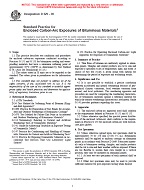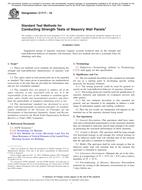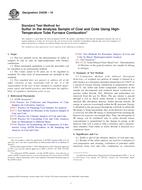This standard was transferred to SEMI (www.semi.org) May 2003
1.1 This test method covers the quantitative determination of elemental areal density on the surface of polished single crystal silicon substrates using total reflection X-ray fluorescence spectroscopy (TXRF) with a monochromatic X-ray source.
1.2 This test method can be used for both n-type and p-type silicon.
1.3 This test method can be used to detect surface elemental contamination that is within the analyte depth of approximately 5 nm for highly mirror-polished silicon wafers. The analytic depth increases with surface roughness.
1.4 This test method is especially useful for determining the surface elemental areal densities in the native oxide or in chemically grown oxide of polished silicon wafers after cleaning.
1.5 This test method is useful for elemental areal densities between 109 and 1015 atoms/cm² within the measurement area. See Annex A1 for a discussion of the relationship between repeatability and detection limit.
1.6 This test method is useful for detecting elements with atomic number between 16 (S) and 92 (U), depending upon the X-ray source provided in the instrument. This test is especially useful for detecting the following metals or elements: potassium, calcium, titanium, vanadium, chromium, manganese, iron, cobalt, nickel, copper, zinc, arsenic, molybdenum, palladium, silver, tin, tantalum, tungsten, platinum, gold, mercury, and lead.
1.7 The detection limit depends upon atomic number, excitation energy, photon flux of excitation X-rays, instrumental background, integration time, and blank value. For constant instrumental parameters, the interference-free detection limits vary over two orders of magnitude as a function of atomic number of the element.
1.8 This test method is nondestructive.
1.9 This test method is complementary to a variety of other test methods:
1.9.1 Electron spectroscopy for chemical analysis that can detect elemental surface areal densities down to the order of 1013 atoms/cm².
1.9.2 Auger electron spectroscopy that can detect elemental surface areal densities down to the order of 10² atoms/cm 2.
1.9.3 Nitrogen-beam Rutherford backscattering spectrometry that can detect down to 1010 atoms/cm² for some elements but cannot mass resolve heavy elements of nearby atomic number.
1.9.4 Secondary ion mass spectrometry that can detect low-atomic-number elemental areal densities in the range of 108 to 1012 atoms/cm² but cannot provide adequate detection limits for transition metals with atomic number between 22 titanium and 30 zinc. This method is destructive.
1.9.5 Vapor phase decomposition (VPD) of surface metals followed by atomic absorption spectroscopy (AAS), where the metal detection limits are from 10 8 to 1011 atoms/cm², but there is no spatial information available and the analysis time is longer than TXRF. This method is destructive.
1.10 This test method uses X-radiation; it is absolutely necessary to avoid personal exposure to X-rays. It is especially important to keep hands or fingers out of the path of the X rays and to protect the eyes from scattered secondary radiation. The use of commercial film badge or dosimeter service is recommended, together with periodic checks of the radiation level at the hand and body positions with a Geiger-Muller counter calibrated with a standard nuclear source. The present maximum permissible dose for total body exposure of an individual to external X-radiation of quantum energy less than 3 MeV over an indefinite period is 1.25 R (3.22 10-4 C/kg) per calendar quarter (equivalent to 0.6 mR/h (1.5 10-7 C/kg-h) as established in the Code of Federal Regulations, Title 10, Part 20. The present maximum permissible dose of hand and forearm exposure under the same conditions is 18.75 R (4.85 X 10 -3 C/kg) per calendar quarter (equivalent to 9.3 mR/h (2.4 10 -6 C/kg-h)). Besides the above stated regulations, various other government and regulatory organizations have their own safety requirements. It is the responsibility of the user to make sure that the equipment and the conditions under which it is used meet these regulations (see 1.11).
1.11 This standard does not purport to address all of the safety concerns, if any, associated with its use. It is the responsibility of the user of this standard to establish appropriate safety and health practices and determine the applicability of regulatory limitations prior to use.
Product Details
- Published:
- 01/01/2000
- Number of Pages:
- 7
- File Size:
- 1 file , 71 KB


